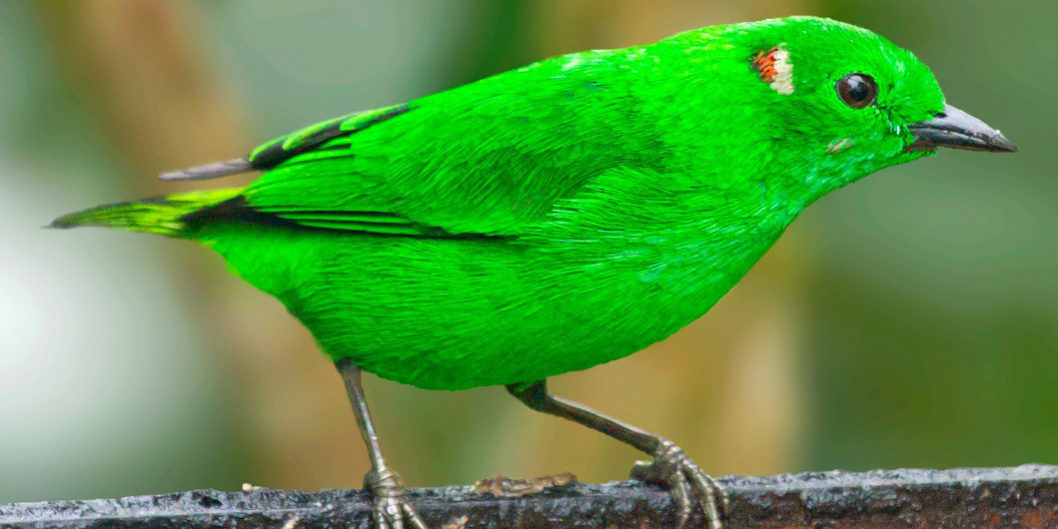Bird of The Week: Glistening-green Tanager
SCIENTIFIC NAME: Chlorochrysa phoenicotis
POPULATION: Unknown
TREND: Decreasing
HABITAT: Cloud forest and edges, tall second growth
True to its name, the Glistening-green Tanager is almost entirely clad in vivid emerald green plumage, save for small tufts of grayish and orange feathers behind its eyes. Both sexes look alike, although the female’s plumage is a slightly more subdued shade.
This stunning bird is usually seen singly or in pairs. Like other South American tanagers, including the Grass-green and Green-headed Tanagers, it also joins mixed-species foraging flocks that move through the trees together in search of insects and fruit.
The Andean Divide
Unlike North America’s migratory Scarlet, Summer, and Western Tanagers, the Glistening-green Tanager is sedentary. This gaudy species only occurs in Andean foothill and lower subtropical forest in western Ecuador and Colombia, in a long but narrow ribbon of range running along the range’s humid western slope (between 2,300 and 7,200 feet in elevation).
Lush forests also occur on the Andes’ other side, on the eastern slope. There, a close relative, the Orange-eared Tanager, can be found. These species are separated by the central Andes’ higher elevations, including higher-elevation cloud forests, grassy and shrubby páramo, and even glaciers. This pattern, of similar-yet-distinct populations separated by the central Andes, occurs in many other species and subspecies.
The Glistening-green and Orange-eared Tanagers are smaller and more active than many tanagers, occurring in the three-species genus Chlorochrysa, from ancient Greek meaning “green-gold.”
It can be surprisingly hard to find small green birds among lush foliage. Listening for them can help. Tuned ears can identify the Glistening-green Tanager’s lispy, wheezy vocalizations. Populations in Ecuador have a slightly more complicated song that adds a series of rapidly accelerating ticking notes that end in a rapid, high-pitched jumble of notes.
Inclined Toward Eating Insects
Although the Glistening-green Tanager feeds on fruit like other tanagers, it visits fruiting trees less regularly than do others, and consumes a larger proportion of small insects and larvae. This restless bird is hard to keep an eye on, but is frequently seen searching for prey high in the understory and into the tree canopy. Active and acrobatic, it often hangs upside down as it gleans insects from the undersides of foliage. It also hops or runs rapidly over mossy branches to probe epiphytes, clumps of moss, and other foliage. In some locations, it comes to feeding stations stocked with bananas and other fruit.
Seeing the Light
Many bird species, from the American Kestrel to the Ruby-throated Hummingbird, can see into the ultraviolet range — an ability that helps birds forage for food or, possibly, appeal to a prospective mate. In the case of the Glistening-green Tanager, such vision helps this songbird detect food in the thick forest canopy, as many insects have body coatings that reflect UV light, and many fruits and berries develop a reflective coating as they ripen.
Although the Glistening-green Tanager’s gray and orange eye patches appear drab in contrast to its almost fluorescent-green feathers, these patches are known to strongly reflect ultraviolet light. Other UV-colored feathers are found on this bird’s wing feathers and shoulders. The jury’s still out on whether or not these areas serve a courtship-related purpose.
Raised Among the Mosses
The Glistening-green Tanager is monogamous, as is the norm in its family. Although little is known about its breeding biology, one observer described this species’ nest as a small, cup-shaped area hollowed out from the moss on the side of a mid-level tree limb.
Both parents feed their newly hatched chicks, continuing to supply them with food for several weeks after they fledge. Young birds may stay with the parents for months, forming a small family group.
Reserves in a Restricted Range
The Glistening-green Tanager has a restricted range on the western slope of the Andes in Colombia and Ecuador, where it is considered uncommon and declining. This area is threatened by habitat loss from deforestation due to mining, agriculture, and expanding development.
Glistening-green Tanagers can be seen at five ABC-supported reserves in Ecuador and Colombia. In addition to providing habitat for rare birds such as the El Oro Parakeet, ABC’s reserve network of 90-plus sites in 15 countries benefits migratory birds ranging from the Cerulean Warbler to the Buff-breasted Sandpiper, while protecting a wide array of biodiversity and restoring thousands of acres of habitat.
SOURCE: American Bird Conservancy (abcbirds.org)


